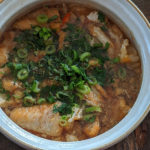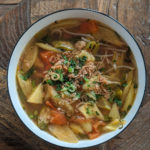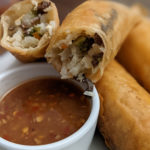Van Nguyen:
Executive Director since 2019
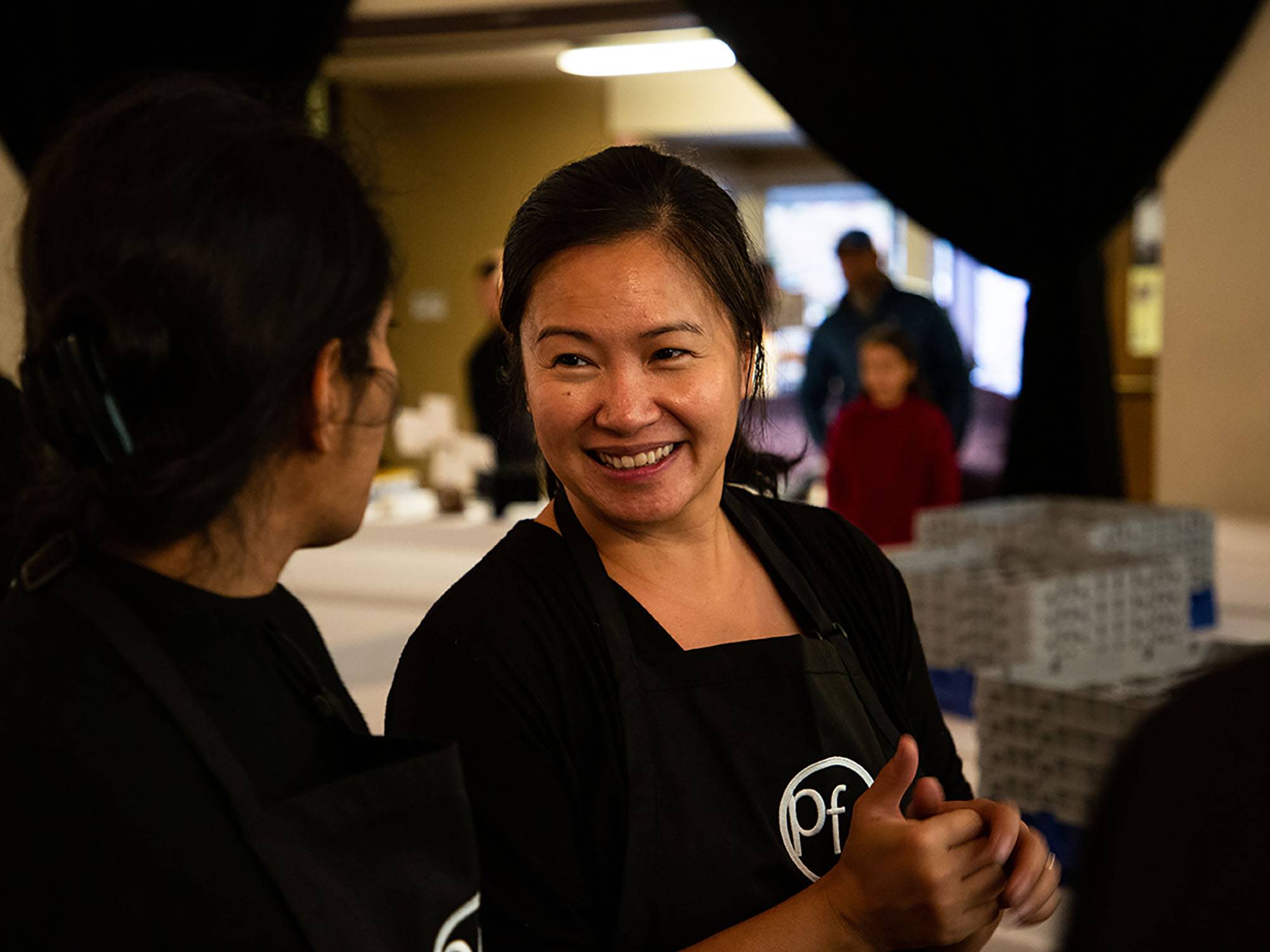
“They’re finding value in their own food, their own stories.”
Van Nguyen’s responsibilities leading Project Feast often pull her away from the kitchen, but she savors any time she has with apprentices. And in her lessons, Van shares foods that flavor her own immigration story.
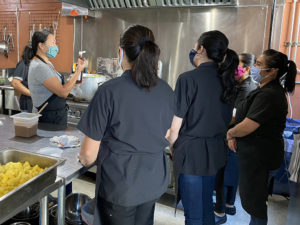
Van teaches a cohort of apprentices to make canh chua.
The scent of toasted garlic drifts through the Project Feast kitchen as Van Nguyen choreographs five apprentices in black chef jackets and masks. The students dart around the stove, dividing sliced okra, taro stem and tomatoes between three steaming pots. Sliced pineapple waits on the stainless steel countertop as all eyes turn to the large bottle of fish sauce in Van’s hand.
The fall cohort is making canh chua, the sweet and sour soup that’s a mainstay in Southern Vietnam, where Van was born and her grandmother still lives. Van explains the broth creates harmony among salt (fish sauce), sour (tamarind) and sweet (sugar). For the apprentices – immigrants from Mexico, Guatemala and Costa Rica – this is their first time cooking with fish sauce.
“You know, in Latin America and Vietnam, we use a lot of the same ingredients, but in different ways,” Van says, calling out the garlic and tomatoes as examples. “But in Vietnam, we don’t use salt. We use the fish sauce in its place.”
She adds a couple of cups of fish sauce to the first 40-quart pot and inhales deeply: “This is the smell of home!” Van tastes the broth, then invites the apprentices to do the same. Next she adds tamarind, then sugar. When the flavor in the first pot matches her memories, Van gives the apprentices their assignment: Add fish sauce, tamarind and sugar to the other two pots, checking the balance until it matches the first.
Van’s leadership responsibilities often pull her out of the kitchen – applying for grants, connecting with partner organizations, and running operations for the Kent-based nonprofit. But it’s these moments around the stove she savors as apprentices and instructors learn about each other through food.
“What strikes me every day is the sharing of stories, and the opening of horizons to all these different flavors,” she says.

Van with her parents and younger sister at a refugee camp in Thailand after leaving Vietnam.
Van’s lesson in canh chua is infused with her own immigration story. She was just 3 years old when her family fled Vietnam in 1979, among the second wave of boat people refugees after the war ended. After a year in a refugee camp in Thailand, the family of four moved to Grand Rapids, Michigan. “There was a church that had a house where they wanted to host a family,” she says. The man next in line gave up his spot because he wanted to relocate to another country, “so we got a house, which a lot of refugees don’t get.”
Van’s childhood memories start in Michigan, and like any American kid, she grew up craving McDonald’s. But home cooking meant Southern Vietnamese comfort food. Her mom sought out vegetables, herbs and spices in the growing Vietnamese community around Grand Rapids. “It was about finding the flavors of home,” Van says. “My dad loved her phở. And to this day, I prefer her recipe over any other Vietnamese recipe for egg rolls because she uses jicama whereas others may use taro.”
As the eldest daughter in a family that grew to five, Van was expected to help prepare meals – a job she resented. “I didn’t have anyone teaching me,” she says. “Whenever it was my turn to cook, they would leave me alone. One time, we didn’t get to eat until 11 o’clock at night because I didn’t know what I was doing.”
But when she left home, moving to New Orleans to study art history at Tulane University, Van began to realize how much she loved Vietnamese food. “In college, I would call my mom for recipes, and I could tell she was really tickled by that,” Van says. She also learned that the smell of fish sauce “wasn’t for everyone.” “I love it,” she says. “But my roommate and I were cooking in the communal kitchen and the next day, there’s a sign: ‘Please don’t cook anything stinky.’ I know that was directed at us. Fortunately, things have changed since then and fish sauce can now be found in many restaurants and home kitchens.”
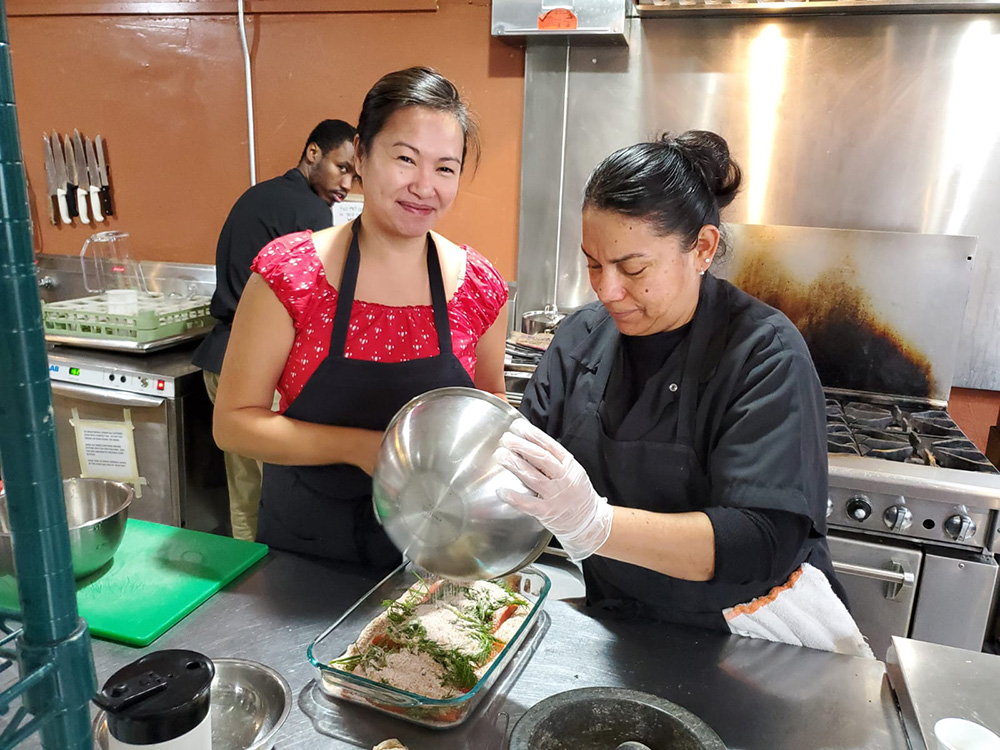
Van teaches 2019 apprentices Lupe and Mohamed how to make a baked salmon dish.
In summer 2019, when Van saw the opportunity to lead Project Feast, her own immigrant experience made the role instantly appealing. “It was just an amazing combination of working with immigrants and supporting them while being around food,” she says. Van and her family had already been planning to move back to Seattle (after a year-long stint in the Midwest to be closer to her father undergoing surgery), and she interviewed – and accepted the offer to succeed founding executive director Veena Prasad – while still on the road.

Van’s turkey with the xawaash spice blend she learned from Mohamed.
As executive director, she didn’t expect the job to include much time in the kitchen, and early on, she helped out only when they took on big catering jobs. But Van learned from the team, incorporating some apprentices’ recipes into her cooking at home. During the 2019 holidays, she roasted a turkey coated in the xawaash Somali spice blend she learned from graduate Mohamed Ali. “It was so good!” she says. “And it was so beautiful because of the color the turkey got from the xawaash.”
“It’s thanks to this job that I’m introduced to all these different flavors,” Van says. “My world has totally expanded, and so has my family’s.”
Then, in March 2020, the coronavirus pandemic shut down the apprenticeship’s training cafe and catering. With revenue streams cut off, the Project Feast team worried the nonprofit’s seventh year might be its last. While they scrambled to figure out how to stay afloat, Van saw an opportunity to partner with organizations like the Food Innovation Network to provide emergency food assistance for the growing number of communities in need. And she suddenly found herself in the kitchen a lot, cooking and teaching the apprentices.
Through that summer and fall, Project Feast prepared thousands of meals for immigrant families and seniors. Project Feast’s years of experience cooking culturally appropriate meals – for example, for Muslim families who could only eat halal or vegetarian meals – meant they could serve a community need other organizations couldn’t. “I would love to see this service become a permanent part of our programming as we can support our food insecure immigrant families while still maintaining our apprenticeship program,” she says.
Van is building partnerships with south King County organizations to expand the food-assistance program, and she hopes Project Feast will qualify for more grants and contracts to sustain these initiatives. The food-assistance programs also provide the opportunity to teach meal scaling to the current apprentices, who remain at the core of the Project Feast mission.
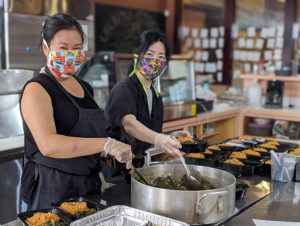
Van and Eun, a 2020 apprentice, prepare family meals.
And while pandemic safety protocols have kept the dining area of the Ubuntu Street Cafe closed for about two years, the team has found new success in offering family-sized meals for takeout each week. The meals are adapted from apprentices’ or the staff’s family recipes; the canh chua in Van’s lesson was part of a weekly family meal serving 124 people.
The family meals provide apprentices an outlet for sharing their stories through food – a process that can be emotional and challenging. Some refugees have suffered traumas and don’t want to talk about their journey. And many immigrants don’t recognize the value of their own food. Van remembers one apprentice, Ana, who was stressed by a graduation assignment to create a family meal. Chef instructor Kausar Ahmed and Van encouraged her to build a meal around a nopales (cactus) stew she had brought from home to share with the team. “I think that opened her eyes to the fact that what she makes at home is delicious, and you can serve it in a cafe,” Van says.
“We’re hopefully helping apprentices pursue a livelihood that they enjoy,” Van says. “They’re finding value in their own food, their own stories.”
Van’s goal is for Project Feast to do more to support graduates in their entrepreneurial efforts. She’s applied for grants to expand the commercial kitchen and dining space, and she dreams of turning over that expanded space to graduates in the evenings so they can do their own pop-up restaurants.
“We encourage them to start small,” Van says. “You might have big dreams and it’s great to dream big, but you have to be realistic and know that very few people make it rich from this. But you can still have your own little corner of the world. There are a lot of successful small businesses. And as long as it’s something you really enjoy, we can help make that happen.”
– Interview and writing by Denise Clifton, Tandemvines Media
Ca Kho To (Catfish in Clay Pot)
Ingredients
- 2 tbsp sugar
- 1 tbsp vegetable oil
- 1 clove garlic, minced
- 2 to 3 dried whole red chiles
- ½ cup Coco Rico
- 3 tbsp fish sauce
- 1 lb catfish fillets, cut in thirds
For garnish:
- ½ tsp black pepper
- 1 green onion, finely chopped
- 4 sprigs of cilantro, finely chopped
Instructions
- 1. Place the sugar in a 1-quart claypot and add just enough water to barely wet it. Heat over medium heat until the sugar starts to brown.
- 2. Add the oil, garlic and chiles. Stir for 1 minute, then add the Coco Rico, fish sauce and catfish pieces.
- 3. Turn the catfish so that the pieces are evenly coated with the sauce. Reduce the heat to a simmer. Cook, covered, until the catfish is firm and almost done (about 5 minutes).
- 4. Uncover and continue to simmer for 2 to 3 minutes so that the sauce is slightly thickened.
- 5. Garnish with black pepper, green onions and cilantro.
- Serves 4.
Canh Chua (Sweet & Sour Soup)
Ingredients
- 1 tbsp vegetable oil
- 1 tsp minced garlic
- 5 cups water
- 2 tbsp fish sauce
- 2 tbsp sugar
- 3 tbsp tamarind paste
- 1 8- inch taro stem, peeled and cut diagonally into ½” slices
- ½ cup okra, sliced diagonally into ½ slices
- 1 large tomato, cut into large chunks
- ½ cup fresh pineapple, cut into bite-sized chunks
- 2 tbsp fried shallots
- 1 cup bean sprouts
- 2 tbsp rice paddy herb, chopped
- 2 tbsp cilantro, chopped
- 2 tbsp Thai basil, chopped
Instructions
- 1. Heat the oil in a large saucepan over medium heat. Add the garlic and stir until fragrant, about 15 seconds. Add the water, fish sauce, sugar, tamarind paste, taro slices, okra and tomatoes and bring to a boil. Reduce the heat and simmer for 5 minutes.
- 2. Add the pineapple and bean sprouts and cook for another 2 minutes. Remove from the heat
- 3. Stir in the herbs. Transfer to a large serving bowl, top with fried shallots, and serve immediately.
- Serves 4
Chicken Phở
Ingredients
- 1 whole chicken + 3 chicken backs or 1 lb chicken wings. Or a total of 2 lbs of any chicken bones you may have laying around
- 10 whole star anise
- 6 whole cloves
- 2 three-inch pieces of ginger, lightly bruised, and charred
- 2 yellow onions, charred
- ¼ cup vegetarian fish sauce
- 1/2 tbsp salt
- 3 tbsp sugar
For serving:
- Phở noodles (Cooked, drained and rinsed)
- Bo vien (Vietnamese beef meatballs, optional)
- Bean sprouts, Thai basil, culantro, limes, thinly sliced white onions, chopped scallions and cilantro
- Chinese breadsticks (Giò Cháo Quẩy)
- Hoisin sauce and Sriracha sauce
Instructions
- 1. In a small skillet, lightly toast the star anise and cloves
- 2. Char the onions and ginger over an open flame
- 3. In a large pot, place the chicken/bones and add water to about 2 inches above the meat (about 4 quarts total). Bring the pot to a boil, skimming off the stuff that floats to the top. Add the charred onions and ginger, and star anise and cloves. Lower the heat and simmer for 1 hour. Check to see if the whole chicken is cooked. If the internal temp reaches 165 degrees, remove the whole chicken, but continue simmering the remaining bones (backs or wings) for another hour. Let the whole chicken cool, shred, and set aside.
- 4. Strain the stock into a clean pot. Add the fish sauce and sugar. Season to taste.
- 5. To serve, divide the noodles into bowls. Put a handful of meat plus sliced white onions. Pour a generous amount of hot broth over the noodles and garnish sprinkle with green onions and cilantro. Tear other herbs into the bowl if you wish. Finish with a squeeze of lime and hoisin/sriracha sauce.
- Serves 6 to 8
Vietnamese Eggrolls
Ingredients
- 1 lb ground pork or chicken
- ½ lb shrimp, deveined and minced
- ½ cup sliced dried wood ear mushrooms, rehydrated and finely chopped
- 1 bundle of dried vermicelli, rehydrated and cut up
- 1 cup of jicama, small dice
- ½ cup of onion, small dice
- 1 bunch of green onions, thinly sliced
- 1 egg
- 1 egg, beaten (set aside)
- Salt & pepper to taste
- Eggroll/Lumpia wrappers
- Oil for deep frying
- nước chấm for serving (Recipe follows)
Instructions
- 1. Mix the first 7 ingredients in a large bowl
- 2. Add the egg and mix well
- 3. Season with salt and pepper
- 4. Place approximately 2 tbsp of filling in the bottom third of the eggroll wrapper, roll, and dab tip of wrapper with a little bit of the beaten egg before sealing. (To see a tutorial on how to roll an eggroll, view our YouTube video starting at the 2 minute mark)
- 5. Deep fry in oil until golden brown. Can also be frozen (on a sheet pan in a single layer before transferring to a Ziploc bag) for up to 3 months.
- 6. Serve with lettuce for wrapping or add to a rice noodle bowl.
- Makes about 30
Nước Chấm
Ingredients
- 2 to 2 ½ tbsp sugar
- 3 to 4 tbsp fresh lime juice
- ½ cup warm water, or as needed
- 3 to 4 tbsp fish sauce
- 1 to 2 Thai chilis, thinly sliced (optional)
- 1 large clove garlic, minced (optional)
Instructions
- 1. In a small bowl, combine 2 tbsp of the sugar, 3 tbsp of the lime juice and the water
- 2. Add the fish sauce
- 3. Add optional ingredients if desired
- Makes about 1 cup

